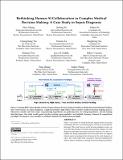| dc.contributor.author | Zhang, Shao | |
| dc.contributor.author | Yu, Jianing | |
| dc.contributor.author | Xu, Xuhai | |
| dc.contributor.author | Yin, Changchang | |
| dc.contributor.author | Lu, Yuxuan | |
| dc.contributor.author | Yao, Bingsheng | |
| dc.contributor.author | Tory, Melanie | |
| dc.contributor.author | Padilla, Lace M. | |
| dc.contributor.author | Caterino, Jeffrey | |
| dc.contributor.author | Zhang, Ping | |
| dc.contributor.author | Wang, Dakuo | |
| dc.date.accessioned | 2024-06-04T16:17:30Z | |
| dc.date.available | 2024-06-04T16:17:30Z | |
| dc.date.issued | 2024-05-11 | |
| dc.identifier.isbn | 979-8-4007-0330-0 | |
| dc.identifier.uri | https://hdl.handle.net/1721.1/155176 | |
| dc.description | CHI '24: Proceedings of the CHI Conference on Human Factors in Computing Systems May 11–16, 2024, Honolulu, HI, USA | en_US |
| dc.description.abstract | Today’s AI systems for medical decision support often succeed on benchmark datasets in research papers but fail in real-world deployment. This work focuses on the decision making of sepsis, an acute life-threatening systematic infection that requires an early diagnosis with high uncertainty from the clinician. Our aim is to explore the design requirements for AI systems that can support clinical experts in making better decisions for the early diagnosis of sepsis. The study begins with a formative study investigating why clinical experts abandon an existing AI-powered Sepsis predictive module in their electrical health record (EHR) system. We argue that a human-centered AI system needs to support human experts in the intermediate stages of a medical decision-making process (e.g., generating hypotheses or gathering data), instead of focusing only on the final decision. Therefore, we build SepsisLab based on a state-of-the-art AI algorithm and extend it to predict the future projection of sepsis development, visualize the prediction uncertainty, and propose actionable suggestions (i.e., which additional laboratory tests can be collected) to reduce such uncertainty. Through heuristic evaluation with six clinicians using our prototype system, we demonstrate that SepsisLab enables a promising human-AI collaboration paradigm for the future of AI-assisted sepsis diagnosis and other high-stakes medical decision making. | en_US |
| dc.publisher | ACM | en_US |
| dc.relation.isversionof | 10.1145/3613904.3642343 | en_US |
| dc.rights | Creative Commons Attribution | en_US |
| dc.rights.uri | https://creativecommons.org/licenses/by/4.0/ | en_US |
| dc.source | Association for Computing Machinery | en_US |
| dc.title | Rethinking Human-AI Collaboration in Complex Medical Decision Making: A Case Study in Sepsis Diagnosis | en_US |
| dc.type | Article | en_US |
| dc.identifier.citation | Zhang, Shao, Yu, Jianing, Xu, Xuhai, Yin, Changchang, Lu, Yuxuan et al. 2024. "Rethinking Human-AI Collaboration in Complex Medical Decision Making: A Case Study in Sepsis Diagnosis." | |
| dc.contributor.department | Massachusetts Institute of Technology. Department of Electrical Engineering and Computer Science | |
| dc.identifier.mitlicense | PUBLISHER_CC | |
| dc.eprint.version | Final published version | en_US |
| dc.type.uri | http://purl.org/eprint/type/ConferencePaper | en_US |
| eprint.status | http://purl.org/eprint/status/NonPeerReviewed | en_US |
| dc.date.updated | 2024-06-01T07:49:59Z | |
| dc.language.rfc3066 | en | |
| dc.rights.holder | The author(s) | |
| dspace.date.submission | 2024-06-01T07:50:00Z | |
| mit.license | PUBLISHER_CC | |
| mit.metadata.status | Authority Work and Publication Information Needed | en_US |
